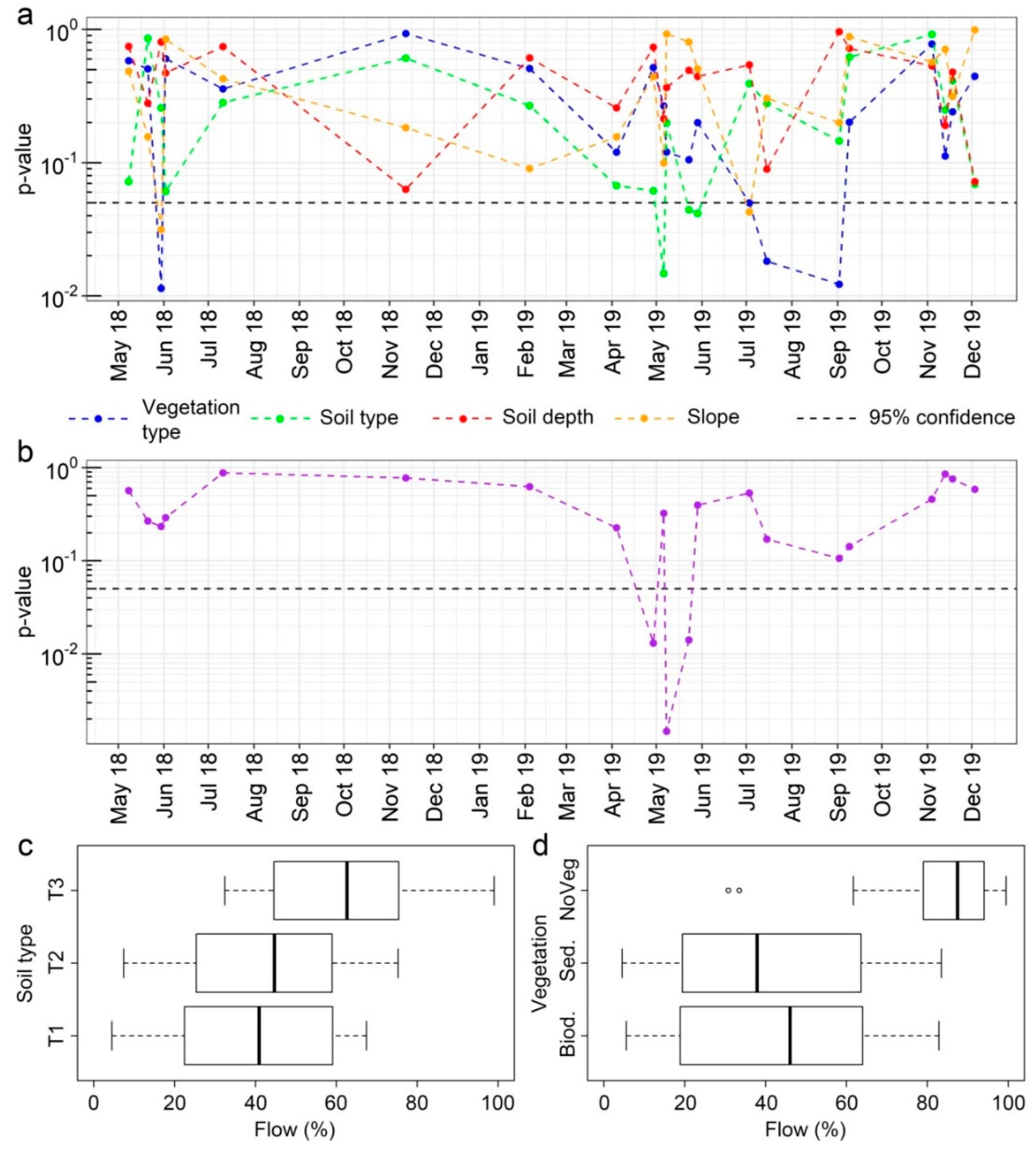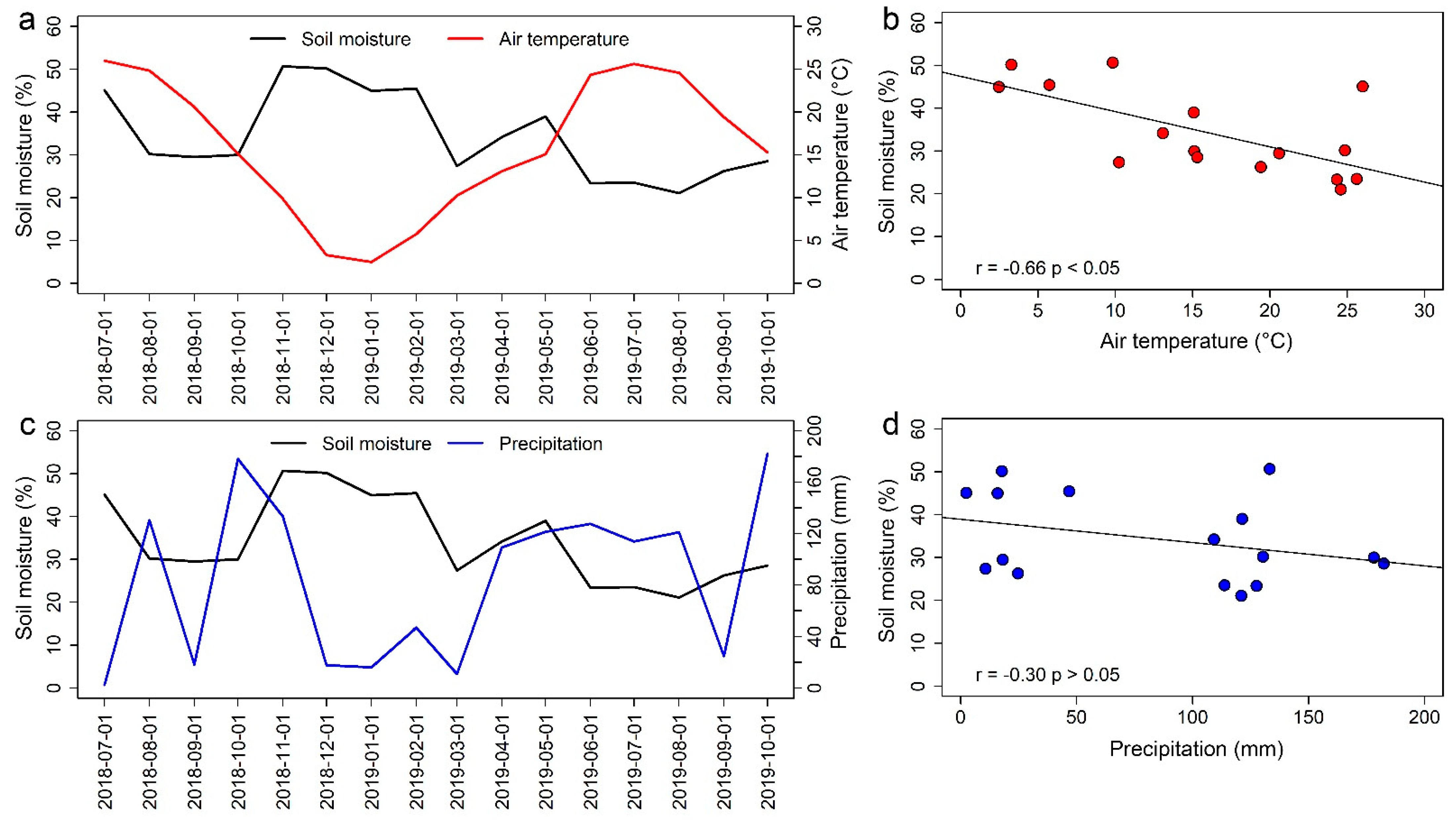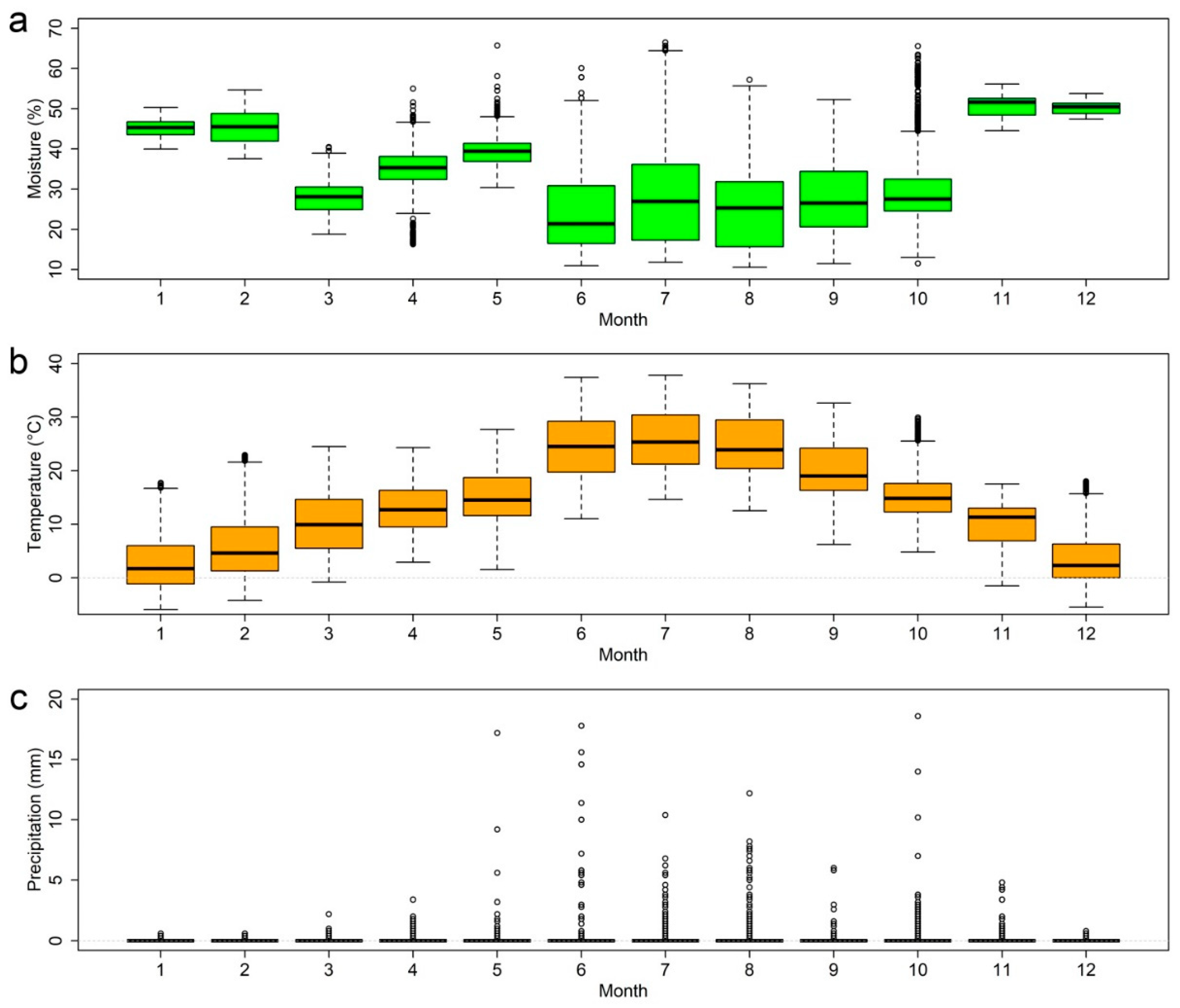Factors Controlling the Hydraulic Efficiency of Green Roofs in the Metropolitan Area of Milan (Italy)
Abstract
:1. Introduction
2. Materials and Methods
2.1. Experimental Setup
- Growing medium type: 3 different types of soils were considered, named T1, T2, and T3. All consisted of a mixture of mineral materials of volcanic origin (zeolites, lava lapilli, and pumice stones with different grain sizes) mixed with organic substances (peat and compost). The following characteristics are reported on the technical sheets of the producers (www.daku.it, www.harpogroup.it, accessed on 10 November 2021). T1 showed an infiltration rate of ≥30 mm/min (DIN standard 18035-4), a water holding capacity of ≥40% v/v at a coefficient pF of 0.7 (UNI EN 13041:2012), and an organic substance content of 5–6% dry w/w [3]. T3 showed an infiltration rate of ≥15–55 mm/min, a water holding capacity of 36–43% v/v at pF 1, and an organic substance of 4.5–4.8% dry w/w. T2 consisted of soil T3, which was enriched with organic matter to reach up to 9.5–10% dry w/w, as we measured in our lab following the Walkley–Black procedure [3].
- Vegetation type: we tested the crassulacean Sedum spp. vs. a grass field composed of annual and perennial species (e.g., Anthemis arvensis, Centaurea cyanus, Papaver rhoeas, Bromopsis erecta, Holcus lanatus, and Silene vulgaris) (hereafter called biodiverse vegetation type) vs. no vegetation (i.e., soil only).
- Growing medium depth: we tested 8 cm vs. 12 cm soil depth for Sedum spp. and 12 cm vs. 15 cm for the grass field.
- Slope: we compared a slope of 1–2% vs. 10–12%.
- Fertilization: some TBs were provided with proper fertilization (NPK fertilizer for soil application with controlled-release nitrogen, provided by green roof producers), to be compared with similar TBs which were not fertilized.
- Our TBs were provided with a collection system for runoff water (Figure 1).
2.2. Hydrological Monitoring
2.3. Statistical Analysis
2.3.1. TB Configuration and Drainage Flow: Analysis of Variance (ANOVA)
2.3.2. Calculation of Peak Flow Delay
2.3.3. Hydrological Parameters and Drainage Flow: Multiple Linear Regression Analysis
3. Results and Discussion
3.1. The Drainage Flow Rate
3.2. GR Characteristics Controlling the Drainage Flow
3.3. Analysis of the Peak Flow Delay
3.4. Hydrological Factors Determining GR Drainage Flow
4. Conclusions
- We calculated a mean drainage flow rate of 51%. Considering the factors influencing the flow rate, we found that: (i) the growing medium material plays a significant role in determining the drainage flow in the spring, at the beginning of the vegetative period; (ii) soils T1 and T2 retain a higher water content than soil T3, which shows a significantly higher drainage capability; (iii) the vegetation cover is able to significantly reduce the drainage flow and its benefits overcome the ones of the growing medium material; (iv) the vegetation type (biodiverse and Sedum) does not play a significant role in the retention processes; (v) concerning the growing medium’s physical characteristics, we observed no significant effects of depth (8–15 cm) and slope (2°–10°) on volume retention. The effect of these parameters on rainfall retention is still unclear.
- We found a precipitation peak delay of 1–2 h for a specific TB characterized by biodiverse vegetation, T3 growing medium with a thickness of 15 cm, and 2° slope. The combination of the TB features and the climatic regime of the Metropolitan Area of Milan allowed us to observe a noteworthy delay compared to the case studies described in the literature. This magnitude of the precipitation peak delay would be sufficient to guarantee environmental benefits (e.g., pollution, flooding, and erosion) as analyzed by Salerno et al. [40] for the same conurbation.
- We found that soil moisture and cumulated precipitation are equally significant factors determining the drainage flow rate, confirming that soil moisture is one of the main parameters that characterize GR drainage capacity. Although we recognize that these parameters are strictly site-specific, we point out that using an easy monitoring parameter like soil moisture can contribute to future applied research on the hydraulic efficiency of GRs.
Author Contributions
Funding
Institutional Review Board Statement
Informed Consent Statement
Data Availability Statement
Acknowledgments
Conflicts of Interest
References
- UN (United Nations). United Nations Final Report on World Urbanization Prospects; United Nations: New York, NY, USA, 2018. [Google Scholar]
- Talebi, A.; Bagg, S.; Sleep, B.E.; O’Carroll, D.M. Water Retention Performance of Green Roof Technology: A Comparison of Canadian Climates. Ecol. Eng. 2019, 126, 1–15. [Google Scholar] [CrossRef]
- US-EPA Methods for the Determination of Total Organic Carbon (TOC) in Soils and Sediments; NCEA-C-1282, EMASC-001; US Environmental Protection Agency, Ecological Risk Assessment Support Center, Office of Research and Development: Las Vegas, NV, USA, 2002.
- Johannessen, B.; Muthanna, T.; Braskerud, B. Detention and Retention Behavior of Four Extensive Green Roofs in Three Nordic Climate Zones. Water 2018, 10, 671. [Google Scholar] [CrossRef] [Green Version]
- IPCC Land-Climate Interaction. In IPCC SRCCL; 2019; 186p, Available online: https://www.ipcc.ch/srccl/chapter/chapter-2/ (accessed on 11 November 2021).
- Palermo, S.A.; Turco, M.; Principato, F.; Piro, P. Hydrological Effectiveness of an Extensive Green Roof in Mediterranean Climate. Water 2019, 11, 1378. [Google Scholar] [CrossRef] [Green Version]
- Kabisch, N.; Korn, H.; Stadler, J.; Bonn, A. Nature-Based Solutions to Climate Change Adaptation in Urban Areas—Linkages Between Science, Policy and Practice. In Nature-Based Solutions to Climate Change Adaptation in Urban Areas: Linkages between Science, Policy and Practice; Kabisch, N., Korn, H., Stadler, J., Bonn, A., Eds.; Theory and Practice of Urban Sustainability Transitions; Springer International Publishing: Cham, Switzerland, 2017; pp. 1–11. ISBN 978-3-319-56091-5. [Google Scholar]
- IUCN. Guidance for Using the IUCN Global Standard for Nature-Based Solutions, 1st ed.; International Union for Conservation of Nature: Gland, Switzerland, 2020. [Google Scholar] [CrossRef]
- EEA Nature-Based Solutions in Europe: Policy, Knowledge and Practice for Climate Change Adaptation and Disaster Risk Reduction—European Environment Agency. Available online: https://www.eea.europa.eu/publications/nature-based-solutions-in-europe (accessed on 25 November 2021).
- Zheng, X.; Zou, Y.; Lounsbury, A.W.; Wang, C.; Wang, R. Green Roofs for Stormwater Runoff Retention: A Global Quantitative Synthesis of the Performance. Resour. Conserv. Recycl. 2021, 170, 105577. [Google Scholar] [CrossRef]
- Garofalo, G.; Palermo, S.A.; Principato, F.; Theodosiou, T.; Piro, P. The Influence of Hydrologic Parameters on the Hydraulic Efficiency of an Extensive Green Roof in Mediterranean Area. Water 2016, 8, 44. [Google Scholar] [CrossRef]
- Jing, R.; Hastings, A.; Guo, M. Sustainable Design of Urban Rooftop Food-Energy-Land Nexus. iScience 2020, 23, 101743. [Google Scholar] [CrossRef]
- Salerno, F.; Gaetano, V.; Gianni, T. Urbanization and Climate Change Impacts on Surface Water Quality: Enhancing the Resilience by Reducing Impervious Surfaces. Water Res. 2018, 144, 491–502. [Google Scholar] [CrossRef]
- Copetti, D.; Marziali, L.; Viviano, G.; Valsecchi, L.; Guzzella, L.; Capodaglio, A.G.; Tartari, G.; Polesello, S.; Valsecchi, S.; Mezzanotte, V.; et al. Intensive Monitoring of Conventional and Surrogate Quality Parameters in a Highly Urbanized River Affected by Multiple Combined Sewer Overflows. Water Supply 2019, 19, 953–966. [Google Scholar] [CrossRef] [Green Version]
- Viviano, G.; Valsecchi, S.; Polesello, S.; Capodaglio, A.; Tartari, G.; Salerno, F. Combined Use of Caffeine and Turbidity to Evaluate the Impact of CSOs on River Water Quality. Water. Air. Soil Pollut. 2017, 228, 330. [Google Scholar] [CrossRef]
- Raimondi, A.; Marchioni, M.; Sanfilippo, U.; Becciu, G. Vegetation Survival in Green Roofs without Irrigation. Water 2021, 13, 136. [Google Scholar] [CrossRef]
- Pirouz, B.; Palermo, S.A.; Turco, M. Improving the Efficiency of Green Roofs Using Atmospheric Water Harvesting Systems (An Innovative Design). Water 2021, 13, 546. [Google Scholar] [CrossRef]
- Krebs, G.; Kuoppamäki, K.; Kokkonen, T.; Koivusalo, H. Simulation of Green Roof Test Bed Runoff. Hydrol. Process. 2016, 30, 250–262. [Google Scholar] [CrossRef]
- Charalambous, K.; Bruggeman, A.; Eliades, M.; Camera, C.; Vassiliou, L. Stormwater Retention and Reuse at the Residential Plot Level—Green Roof Experiment and Water Balance Computations for Long-Term Use in Cyprus. Water 2019, 11, 1055. [Google Scholar] [CrossRef] [Green Version]
- Campisano, A.; Modica, C.; Gullotta, A. Long-Term Experiments for the Evaluation of the Potential for Storm Water Control of Modular Blue Roofs in Mediterranean Climate. Urban Water J. 2021, 18, 33–42. [Google Scholar] [CrossRef]
- Todorov, D.; Driscoll, C.T.; Todorova, S. Long-Term and Seasonal Hydrologic Performance of an Extensive Green Roof. Hydrol. Process. 2018, 32, 2471–2482. [Google Scholar] [CrossRef]
- Longobardi, A.; D’Ambrosio, R.; Mobilia, M. Predicting Stormwater Retention Capacity of Green Roofs: An Experimental Study of the Roles of Climate, Substrate Soil Moisture, and Drainage Layer Properties. Sustainability 2019, 11, 6956. [Google Scholar] [CrossRef] [Green Version]
- Beecham, S.; Razzaghmanesh, M. Water Quality and Quantity Investigation of Green Roofs in a Dry Climate. Water Res. 2015, 70, 370–384. [Google Scholar] [CrossRef] [PubMed]
- Ferrans, P.; Rey, C.; Pérez, G.; Rodríguez, J.; Díaz-Granados, M. Effect of Green Roof Configuration and Hydrological Variables on Runoff Water Quantity and Quality. Water 2018, 10, 960. [Google Scholar] [CrossRef] [Green Version]
- Hellies, M.; Deidda, R.; Viola, F. Retention Performances of Green Roofs Worldwide at Different Time Scales. Land Degrad. Dev. 2018, 29, 1940–1952. [Google Scholar] [CrossRef]
- Fassman-Beck, E.; Voyde, E.; Simcock, R.; Hong, Y.S. 4 Living Roofs in 3 Locations: Does Configuration Affect Runoff Mitigation? J. Hydrol. 2013, 490, 11–20. [Google Scholar] [CrossRef]
- ISTAT Forme, Livelli e Dinamiche dell’Urbanizzazione in Italia. 2017. Available online: www.istat.it/it/files/2017/05/urbanizzazione.pdf (accessed on 20 October 2021).
- Municipality of Milan. 2020. Available online: https://www.comune.milano.it/-/milano-green-week.-un-futuro-con-13-milioni-di-mq-di-tetti-verdi-in-citta (accessed on 20 October 2021).
- Palla, A.; Gnecco, I.; Lanza, L. Hydrologic Restoration in the Urban Environment Using Green Roofs. Water 2010, 2, 140–154. [Google Scholar] [CrossRef]
- Stovin, V. The Potential of Green Roofs to Manage Urban Stormwater: The Potential of Green Roofs to Manage Urban Stormwater. Water Environ. J. 2010, 24, 192–199. [Google Scholar] [CrossRef]
- Copetti, D.; Tartari, G.; Valsecchi, L.; Salerno, F.; Viviano, G.; Mastroianni, D.; Yin, H.; Viganò, L. Phosphorus Content in a Deep River Sediment Core as a Tracer of Long-Term (1962–2011) Anthropogenic Impacts: A Lesson from the Milan Metropolitan Area. Sci. Total Environ. 2019, 646, 37–48. [Google Scholar] [CrossRef] [PubMed]
- Sims, A.W.; Robinson, C.E.; Smart, C.C.; O’Carroll, D.M. Mechanisms Controlling Green Roof Peak Flow Rate Attenuation. J. Hydrol. 2019, 577, 123972. [Google Scholar] [CrossRef]
- Czemiel Berndtsson, J. Green Roof Performance towards Management of Runoff Water Quantity and Quality: A Review. Ecol. Eng. 2010, 36, 351–360. [Google Scholar] [CrossRef]
- Salerno, F.; Thakuri, S.; Guyennon, N.; Viviano, G.; Tartari, G. Glacier Melting and Precipitation Trends Detected by Surface Areachanges in Himalayan Ponds. Cryosphere 2016, 10, 1433–1448. [Google Scholar] [CrossRef] [Green Version]
- Twarakavi, N.K.C.; Sakai, M.; Šimůnek, J. An Objective Analysis of the Dynamic Nature of Field Capacity. Water Resour. Res. 2009, 45. [Google Scholar] [CrossRef]
- Assouline, S.; Or, D. The Concept of Field Capacity Revisited: Defining Intrinsic Static and Dynamic Criteria for Soil Internal Drainage Dynamics. Water Resour. Res. 2014, 50, 4787–4802. [Google Scholar] [CrossRef]
- Marziali, L.; Rosignoli, F.; Drago, A.; Pascariello, S.; Valsecchi, L.; Rossaro, B.; Guzzella, L. Toxicity Risk Assessment of Mercury, DDT and Arsenic Legacy Pollution in Sediments: A Triad Approach under Low Concentration Conditions. Sci. Total Environ. 2017, 593–594, 809–821. [Google Scholar] [CrossRef]
- Venables, W.N.; Ripley, B.D. Modern Applied Statistics with S, 4th ed.; Statistics and Computing; Springer: New York, NY, USA, 2010; ISBN 978-1-4419-3008-8. [Google Scholar]
- Shapiro, S.S.; Wilk, M.B. An Analysis of Variance Test for Normality (Complete Samples). Biometrika 1965, 52, 591. [Google Scholar] [CrossRef]
- Grömping, U. Relative Importance for Linear Regression in R: The Package Relaimpo. J. Stat. Softw. 2006, 17. [Google Scholar] [CrossRef] [Green Version]
- Gromaire, M.C.; Ramier, D.; Seidl, M.; Berthier, E.; Saad, M.; de Gouvello, B. Impact of Extensive Green Roofs on the Quantity and the Quality of Runoff—First Results of a Test Bench in the Paris Region; GRAIE: Lyon, France, 2013. [Google Scholar]
- Silva, M.d.; Najjar, M.K.; Hammad, A.W.A.; Haddad, A.; Vazquez, E. Assessing the Retention Capacity of an Experimental Green Roof Prototype. Water 2019, 12, 90. [Google Scholar] [CrossRef] [Green Version]
- Cirrincione, L.; La Gennusa, M.; Peri, G.; Rizzo, G.; Scaccianoce, G.; Sorrentino, G.; Aprile, S. Green Roofs as Effective Tools for Improving the Indoor Comfort Levels of Buildings—An Application to a Case Study in Sicily. Appl. Sci. 2020, 10, 893. [Google Scholar] [CrossRef] [Green Version]
- Liu, H.; Kong, F.; Yin, H.; Middel, A.; Zheng, X.; Huang, J.; Xu, H.; Wang, D.; Wen, Z. Impacts of Green Roofs on Water, Temperature, and Air Quality: A Bibliometric Review. Build. Environ. 2021, 196, 107794. [Google Scholar] [CrossRef]
- Stovin, V.; Poë, S.; De-Ville, S.; Berretta, C. The Influence of Substrate and Vegetation Configuration on Green Roof Hydrological Performance. Ecol. Eng. 2015, 85, 159–172. [Google Scholar] [CrossRef] [Green Version]
- Nagase, A.; Dunnett, N. Amount of Water Runoff from Different Vegetation Types on Extensive Green Roofs: Effects of Plant Species, Diversity and Plant Structure. Landsc. Urban Plan. 2012, 104, 356–363. [Google Scholar] [CrossRef]
- Berretta, C.; Poë, S.; Stovin, V. Reprint of “Moisture Content Behaviour in Extensive Green Roofs during Dry Periods: The Influence of Vegetation and Substrate Characteristics”. J. Hydrol. 2014, 516, 37–49. [Google Scholar] [CrossRef]
- Chenot, J.; Gaget, E.; Moinardeau, C.; Jaunatre, R.; Buisson, E.; Dutoit, T. Substrate Composition and Depth Affect Soil Moisture Behavior and Plant-Soil Relationship on Mediterranean Extensive Green Roofs. Water 2017, 9, 817. [Google Scholar] [CrossRef] [Green Version]
- Carter, T.L.; Rasmussen, T.C. Hydrologic behavior of vegetated roofs. J. Am. Water Resour. Assoc. 2006, 42, 1261–1274. [Google Scholar] [CrossRef]
- Villarreal, E.L. Runoff Detention Effect of a Sedum Green-Roof. Hydrol. Res. 2007, 38, 99–105. [Google Scholar] [CrossRef]
- Wong, G.K.L.; Jim, C.Y. Quantitative Hydrologic Performance of Extensive Green Roof under Humid-Tropical Rainfall Regime. Ecol. Eng. 2014, 70, 366–378. [Google Scholar] [CrossRef]
- Stovin, V.; Vesuviano, G.; Kasmin, H. The Hydrological Performance of a Green Roof Test Bed under UK Climatic Conditions. J. Hydrol. 2012, 414–415, 148–161. [Google Scholar] [CrossRef]
- DeNardo, J.C.; Jarrett, A.R.; Manbeck, H.; Beattie, D.J.; Berghage, R. Stormwater mitigation and surface temperature reduction by green roofs. Trans. ASAE 2005, 48, 1491–1496. [Google Scholar] [CrossRef]





Publisher’s Note: MDPI stays neutral with regard to jurisdictional claims in published maps and institutional affiliations. |
© 2021 by the authors. Licensee MDPI, Basel, Switzerland. This article is an open access article distributed under the terms and conditions of the Creative Commons Attribution (CC BY) license (https://creativecommons.org/licenses/by/4.0/).
Share and Cite
Salerno, F.; Valsecchi, L.; Minoia, R.; Copetti, D.; Tartari, G.; Guyennon, N.; Colombo, N.; Pirola, N.; Barozzi, B.; Bellazzi, A.; et al. Factors Controlling the Hydraulic Efficiency of Green Roofs in the Metropolitan Area of Milan (Italy). Sustainability 2021, 13, 13638. https://doi.org/10.3390/su132413638
Salerno F, Valsecchi L, Minoia R, Copetti D, Tartari G, Guyennon N, Colombo N, Pirola N, Barozzi B, Bellazzi A, et al. Factors Controlling the Hydraulic Efficiency of Green Roofs in the Metropolitan Area of Milan (Italy). Sustainability. 2021; 13(24):13638. https://doi.org/10.3390/su132413638
Chicago/Turabian StyleSalerno, Franco, Lucia Valsecchi, Riccardo Minoia, Diego Copetti, Gianni Tartari, Nicolas Guyennon, Nicola Colombo, Niccolò Pirola, Benedetta Barozzi, Alice Bellazzi, and et al. 2021. "Factors Controlling the Hydraulic Efficiency of Green Roofs in the Metropolitan Area of Milan (Italy)" Sustainability 13, no. 24: 13638. https://doi.org/10.3390/su132413638
APA StyleSalerno, F., Valsecchi, L., Minoia, R., Copetti, D., Tartari, G., Guyennon, N., Colombo, N., Pirola, N., Barozzi, B., Bellazzi, A., & Marziali, L. (2021). Factors Controlling the Hydraulic Efficiency of Green Roofs in the Metropolitan Area of Milan (Italy). Sustainability, 13(24), 13638. https://doi.org/10.3390/su132413638







